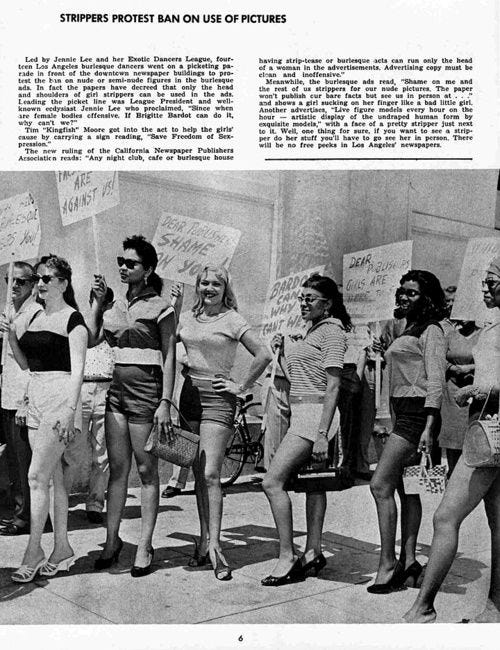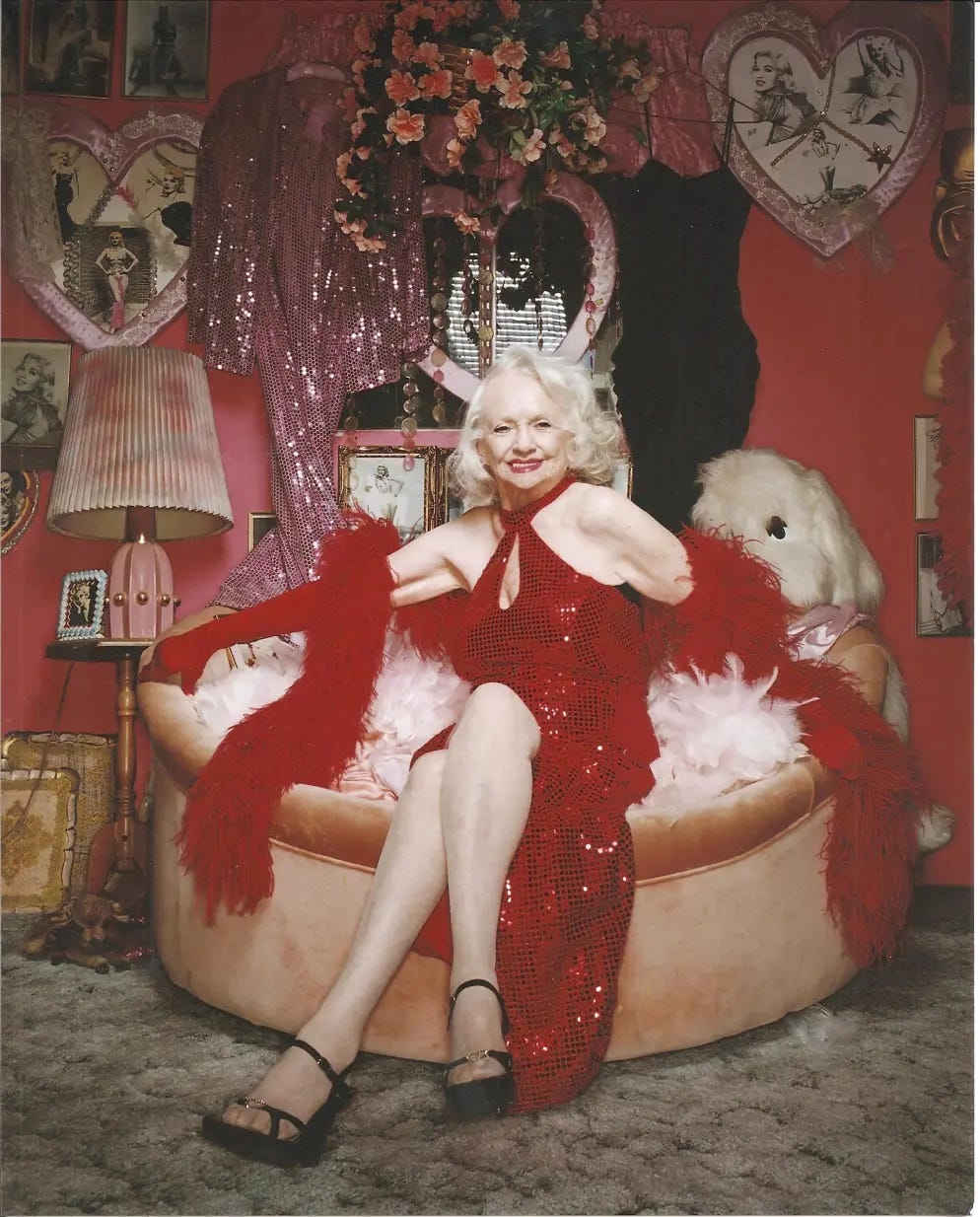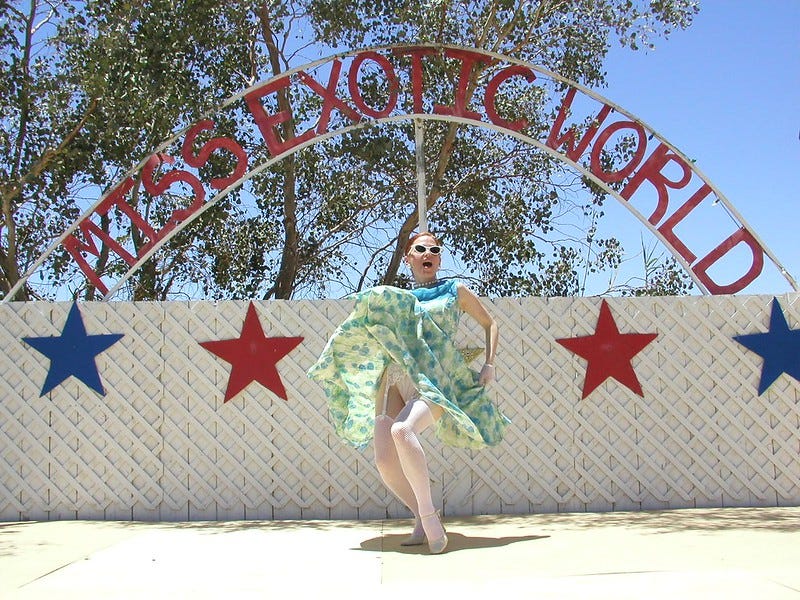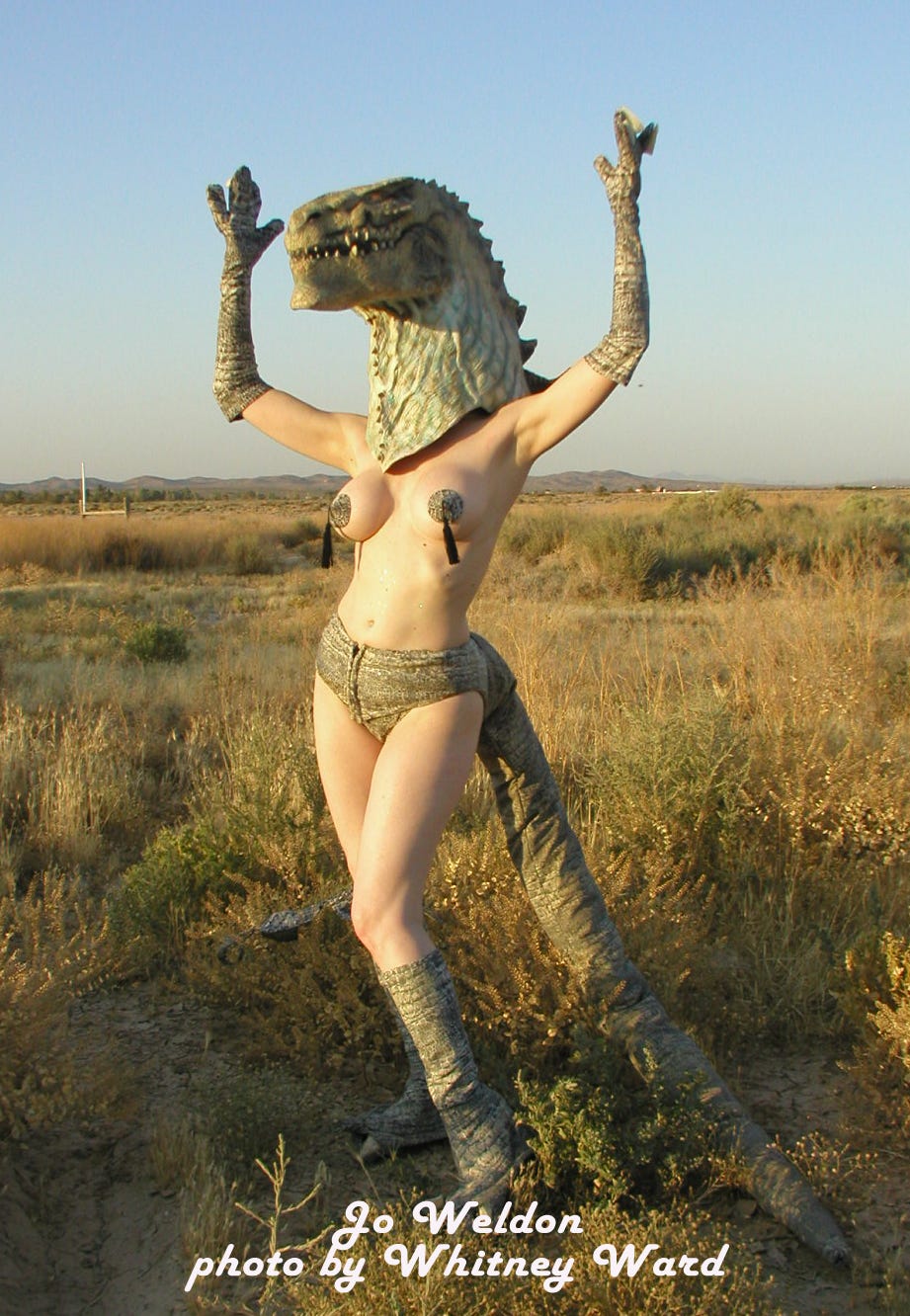A group of protesters against newspapers censoring burlesque stripteasers’ ads in 1959, including Burlesque Hall of Fame founder Jennie Lee holding a sign that says “shame on you.” Image source
I’ll be spending today getting ready to go to The Burlesque Hall of Fame Weekender, an event I’ve been attending through its various versions since 2004. The event is a fundraiser for the Burlesque Hall of Fame Museum and consists primarily of three nights of shows. Thursday there’s The Movers, Shakers, and Innovators Showcase, featuring a range of performances from around the world (though mostly the United States) with an emphasis on including the more subversive, comedic, and narrative styles. Friday night is Legends Night (formally known as the “Titans of Tease”), featuring elder performers and some title holders. Saturday is the M Exotic World Pageant, from whence the title holders originate. In addition to the shows there are other events, including classes by the legends, and on Sunday there is a legends’ panel where performers from decades past tell stories of what it was like to work in burlesque before 1980 (which is when I started stripping in strip joints). Some of their careers go back as far as the 1950s. When I started going, their careers went as far back as the 1930s, but sadly we have lost so many of them.
The Legends are not guests at our party; we are guests at theirs. The first time I attended in 2004, The Burlesque Hall of Fame was a raw Mecca in the Mojave Desert called Exotic World. I had heard of it long before. As a stripper with an interest in the history of the job that came to define me, a job that both saved me and traumatized me, both helped me discover and developed who I am, that I both struggle against and celebrate, knowing that there was a museum devoted to stripper history made me feel connected to the larger culture in a way that most of society denied. Even before I was an activist and was subjected to the explicit perspectives of legislators and professional moralists, I experienced the exclusion of strippers and other sex workers from society. People often talked about us as if we weren’t among them, as if we were dropped off from a space ship at the beginning of our shifts and picked up at the end of them, as if strippers children never mingled with their own, as if we were never in their supermarkets and libraries, as if we were not only stigmatized by our work but existed entirely within it immured from society in a vehicle that traveled entirely different roads from decent everyday vehicles. The mere idea that we might have our own museum and our own celebration shattered that isolation. Of course it was treated as a crackpot museum, but it existed – and it called itself a museum!
Most importantly of all, to me, was that it had been started by strippers themselves. The Burlesque Hall of Fame originated as The Exotic Dancers’ League, organized by 1950s and 60s burlesque star Jennie Lee “The Bazoom Girl” as an unofficial union for burlesque striptease performers. Over time the league became a stripteasers’ reunion at her bar The Sassy Lassy. During gatherings, attendees would tack up their g-strings and promo photos on the walls, and eventually Jennie saw that it could be a legitimate museum. She moved her collection to a goat farm in the middle of the desert, where she had the idea of having a complex that included the museum, a striptease school, and a retirement home for elder performers.
When she got ill with breast cancer she invited her friend Dixie Evans “The Marilyn Monroe of Burlesque” to take over the operations while she recovered. However, Jennie passed at the age of 61 in 1991, and Dixie inherited Jennie’s legacy. In order to draw attention to the museum and raise funds to keep it going, Dixie created the Miss Exotic World pageant.
Above: Dixie at the Helendale museum. Image source
I finally made it to the goat farm 21 years ago with a group of neo-burlesquers including Dirty Martini
, Indigo Blue,
Erochica Bamboo
, Bambi the Mermaid
, and Alotta Boutte https://www.facebook.com/watch/?v=5348058748556611 ,
among many important others, all of whom are still friends, and are crucially important to me in a way that extends beyond the burlesque community. Those of us coming from New York had to fly to Long Beach, drive to Helendale, and then drive to Wild Road, which was as uncultivated as its name implied. Our car full of rowdy strippers trundled through an iron gate with an arch over it proclaiming “Exotic World Museum” and topped with a gold star. The gate guarded nothing, as it wasn’t joined to much of a fence, but it gave the sense of entering something worthy of protection. This would prove to be representative of Dixie’s approach to burlesque and neo-burlesque: celebrate the art form without gatekeeping it.
Above: The gate to Exotic World. Image source
We bumpily approached the cluster of buildings and obeyed the sign that asked us to honk three times. Dixie emerged, blinking in the desert sunlight, all blonde hair and eyelashes and red feathers and sequins, and in a breathy Marilyn voice invited us to come on in. We didn’t have to be told twice — I’d been dying to see this museum for years. It was so far beyond my expectations that for a time it became my life’s work.
Lots of people were already inside when we entered: burlesque strippers in corsets, ruffled panties, and tiny hats (a trend later to be mercilessly and unreasonably mocked – I say wear the fucking tiny hat, by all means), along with tattoos and Bettie bangs; bikers in full leather regalia, who would later rev their engines and scream throughout the pageant; curiosity seekers and lovers of burlesque and retro culture; and lots of photographers, of which I intended to be one. Dixie later told us that at the first Miss Exotic World Pageant in 1991, there were more photographers than contestants.
Above: Me posing on the stage at Exotic World. Photo by Don Spiro.
Above: Me posing in the desert behind the stage. Photo by Whitney Ward.
My interview with Dixie in 2007
Exotic World and the Burlesque Revival (documentary trailer)
A few days ago I pulled a tarot card, asking how to mentally and emotionally approach my trip to Vegas for the fundraiser this year. The card was the six of cups.
I think you can tell without any knowledge of tarot what this card is about. I have a lot of knowledge of tarot (I’ve been reading since 1976) and I took a deep breath of joy when I saw it. It represents a fondness for the past, memories of friends and family, emotional and spiritual roots. After seeing it, I felt a sense of relief, because I do have intense social anxiety about big events, and over the years my feelings around this event in particular have gotten increasingly complex. It reminded me that it is an essential time to reconnect to what originally inspired me to work for BHoF, and the philosophy that Dixie instilled in me.
This is just part of a story that I’ll be telling in more detail, possibly later today and possibly ten years from now. I’m not just an attendee at BHoF; I’ve been part of the various teams working to develop the fundraiser since I first began going. I’ve been there every year, including the pandemic years I attended online, for 20 years. This year is my 21st year, and possibly my last, for reasons I’m planning to share. I’ve been having a hard time writing posts over the past month due to shows and events, but once I get back from Vegas I have a host of pieces I’ve begun that I intend to finish and post. Right now I’m journaling about Exotic World for you – and I have such a story to tell you.









This gave me the most vivid memory of discovering burlesque and sent me racing for my book shelf. The first book I ever bought myself had a foreword from Dixie, and her photo. I thought she was the most glamorous woman I'd ever laid eyes on and those three pages from her changed my life.
Thank you for all those years of work Jo. I hope this years weekender is connective, affirming and joyous.
You’re so in the money about the us and them, strippers and such being on the outside. Me though, it was that delineation that made me feel I belonged someplace.